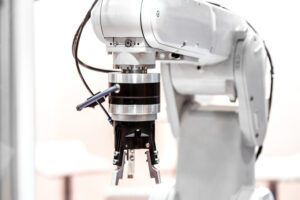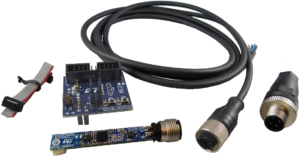In our blog post “From preventive to predictive maintenance” we talked about the advantages of predictive maintenance versus traditional approaches to equipment maintenance. Here, we’ll talk in more depth on how to approach setting up such a predictive maintenance system and some of the tools available for this.
If you want to check some of these out in person you will have the opportunity at Electronica in Munich from November 13-16. where ST will be showcasing solutions for condition monitoring and predictive maintenance
The smart approach to Condition Monitoring

The first step in predictive maintenance is to create a system to monitor the condition of the equipment. Usually, a machine wears down over time; this results in the gradual changes in specifications or parameters that can be measured. In principle, the earlier we can detect a defect, the lower the cost will be for maintenance and the lower the risk for lost production time. Until recently, equipment specialists and maintenance crews monitored fault indicators like vibration and sound emissions almost exclusively with discrete portable sensor probes based on piezoelectric or ultrasound sensing principles. However, diagnostic equipment based on these technologies is relatively complex and expensive and there are also limitations related to repeatability, data management, and analysis.
State-of-the-art electronics and advanced algorithms have enabled a new approach. We can now apply small, low-power sensing devices directly on machines to monitor multiple parameters, pre-process the acquired signal data, and send the data to local, remote, or cloud-based analysis and control facilities. These compact smart sensor nodes generally consist of sensors, a microcontroller, power-management circuitry, and wired or wireless connectivity and offer substantial advantages over traditional condition-monitoring equipment.
The advantages of Smart Sensor Nodes
First, there is a good economic argument. Smart sensor nodes with autonomous operation cost much less than portable piezoelectric probes and the skilled technicians required to operate them. Next, there is the advantage of having repeatable, reliable, and timely data. This is thanks to continuous measurement and analysis during machine operation and is not limited to maintenance schedules that may miss early or critical failure signs. The next benefit is the ability to use intelligent algorithms to analyze data locally at the node and trigger immediate local action to protect the equipment and ensure worker safety. The sensor node can also be configured to account for increasing tolerances of aging equipment with automatic adjustment of the monitoring parameters over time.
In addition to the advantages that local sensor nodes offer in the monitoring of individual machines, there are even more benefits when the sensor nodes connect to the cloud and enable the gathering of large amounts of data for deeper predictive-maintenance analysis.
Getting started with a predictive system
Setting up a predictive maintenance solution based on a smart sensor system may take one to two years, involving several important steps:
- Defining the system architecture.
- Finding sensors with the right accuracy and stability, at the right cost and availability.
- Defining the required specification for the microcontroller including computational power, memory, and interfaces.
- Choosing the connectivity technologies.
- Designing the power management stage and suitable form factor.
- Implementing the required analytics as well as characterizing the system.
- Validating everything in a real application scenario.
ST has designed a dedicated ecosystem to facilitate the evaluation of the products that predictive-maintenance system designers may need and to speed the deployment for field-testing characterization using pre-validated tools. ST offers vibration analysis tools for both a wired sensor-node reference design kit and a wireless sensor node with a data connection to the Cloud.
Wired Sensor Node Reference Design Kit with IO-Link capabilities
 The STEVAL-BFA001V1B is a small form factor industrial reference design kit for condition monitoring and predictive maintenance based on wired connectivity.
The STEVAL-BFA001V1B is a small form factor industrial reference design kit for condition monitoring and predictive maintenance based on wired connectivity.
The hardware development kit consists of an industrial sensor board with multiple sensors, a microcontroller and a device controller for sending data via wired connectivity, an adapter for the ST-LINK/V2-1 programming and debugging tool, and essential cables and connectors.
The firmware package STSW-BFA001V1 runs on an STM32F4 microcontroller. It contains complete demo examples based on a 3D accelerometer library with advanced signal processing for predictive maintenance, including time analysis (Speed RMS, acceleration peak), frequency analysis (Programmable FFT size, averaging, overlapping and windowing), sound analysis (PDM to PCM, sound pressure, Audio FFT). The software package includes drivers for an atmospheric pressure sensor, as well as a relative humidity and temperature sensor.
Wireless sensor node with Cloud connection
The software package (X-CUBE-WATSON) runs on a wirelessly connected IoT node with data transfer to IBM Watson IoT which can be used to transmit sensor data and receive commands from remote applications.
This package lets developers jump-start end-to-end IoT development letting them focus on additional functionality rather than developing basic functionality.
The package is further extended with pre-integrated algorithms for the processing of accelerometer data which can be used to detect vibration from devices such as motors, fans, and pumps. Maximum frequencies and wear-and-tear conditions of the device under test are transmitted together with raw sensor data to IBM Watson IoT, enabling rapid development of solutions for industrial Condition Monitoring and Predictive Maintenance.
Predictive Maintenance is one of the key enablers of Smart Factories and the technologies to implement make it happen are already here: sensing, connectivity, security, power management, and embedded processing with Artificial Intelligence capabilities. Add cloud computing and connectivity and you have all the ingredients to create sophisticated, high-performance systems that can deliver the full benefits of Predictive Maintenance applications.
Join us at Electronica in Munich from November 13-16 to see for yourself some of ST’s solutions for condition monitoring and predictive maintenance.
